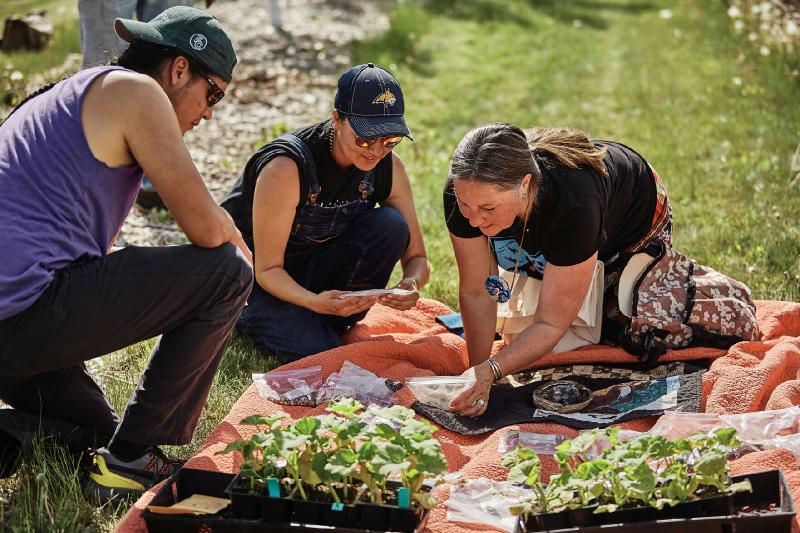News of the weird: Food sovereignty movement sprouts as bison return to indigenous communities
By: JIM ROBBINS KFF (East Oregonian)


Some are intentionally going back. In fact, going back is providing opportunities.

BOZEMAN, Mont. — Behind American Indian Hall on the Montana State University campus, ancient life is growing.
Six-foot-tall corn plants tower over large green squash and black-and-yellow sunflowers. Around the perimeter, stalks of sweetgrass grow.
The seeds for some of these plants grew for millennia in Native Americans' gardens along the upper Missouri River. It's one of several Native American ancestral gardens growing in the Bozeman area, totaling about an acre. Though small, the garden is part of a larger, multifaceted effort around the country to promote "food sovereignty" for reservations and tribal members off reservation, and to reclaim aspects of Native American food and culture that flourished in North America for thousands of years before the arrival of European settlers. Restoring bison to reservations, developing community food gardens with ancestral seeds, understanding and collecting wild fruits and vegetables, and learning how to cook tasty meals with traditional ingredients are all part of the movement.
"We are learning to care for plant knowledge, growing Indigenous gardens, cultivating ancestral seeds — really old seeds from our relatives the Mandan, Hidatsa, and Arikara: corn, beans, squash, and sunflowers," said Jill Falcon Ramaker, an assistant professor of community nutrition and sustainable food systems at Montana State. She is a member of the Turtle Mountain Band of Anishinaabe.
"A lot of what we are doing here at the university is cultural knowledge regeneration," she said.
But it also has a very practical application: to provide healthier, cheaper, and more reliable food supplies for reservations, which are often a long way from supermarkets, and where processed foods have helped produce an epidemic of diabetes and heart disease.
Many reservations are food deserts where prices are high and processed food is often easier to come by than fresh food. The Montana Food Distribution Study, a 2020 paper funded by the U.S. Department of Agriculture, found that the median cost in the state of a collection of items typically purchased at a grocery store is 23% higher on a reservation than off.
"With food sovereignty we are looking at the ability to put that healthy food and ancestral foods which we used to survive for thousands of years, putting those foods back on the table," Ramaker said. What that means exactly can vary by region, depending on the traditional food sources, from wild rice in the Midwest to salmon on the Pacific coast.
Central to the effort, especially in Montana, are bison, also referred to as buffalo. In 2014, 13 Native nations from eight reservations in the U.S. and Canada came together to sign the Buffalo Treaty, an agreement to return bison to 6.3 million acres that sought "to welcome BUFFALO to once again live among us as CREATOR intended by doing everything within our means so WE and BUFFALO will once again live together to nurture each other culturally and spiritually."
Nearly a decade later, dozens of tribes have buffalo herds, including all seven reservations in Montana.
The buffalo-centered food system was a success for thousands of years, according to Ramaker, who directs both the regional program, known as the Buffalo Nations Food Systems Initiative — a collaboration with the Native American Studies Department and College of Education, Health and Human Development at Montana State — and the Montana-specific effort, known as the Montana Indigenous Food Sovereignty Initiative. It wasn't a hand-to-mouth existence, she wrote in an article for Montana State, but a "knowledge of a vast landscape, including an intimate understanding of animals, plants, season, and climate, passed down for millennia and retained as a matter of life and death."
With bison meat at the center of the efforts, the BNFSI is working to bring other foods from the northern Plains Native American diet in line with modern palates.
The BNFSI has received a $5 million grant from the U.S. Department of Agriculture to carry out that work, in partnership with Nueta Hidatsa Sahnish College in New Town, North Dakota.
Life on reservations is partly to blame for many Native people eating processed foods, Ramaker said. Food aid from the federal government, known as the Commodity Supplemental Food Program, has long been shipped to reservations in the form of boxes full of packaged foods. "We were forced onto the reservations, where there was replacement food sent by the government — white flour, white sugar, canned meat, salt, and baking powder," she said.
Experts say processed foods contribute to chronic inflammation, which in turn leads to heart disease, cancer, and diabetes, which occurs at three times the rate in Native Americans as it does in white people.
Studies show that people's mental and physical health declines when they consume a processed food diet. "In the last decade there's a growing amount of research on the impact of good nutrition on suicide ideation, attempts, and completion," said KayAnn Miller, co-executive director of the Montana Partnership to End Childhood Hunger in Bozeman, who is also involved with the BNFSI.
All Native American reservations in Montana now have community gardens, and there are at least eight gardens on the Flathead Reservation north of Missoula, home to the Confederated Salish and Kootenai Tribes. The tribe is teaching members to raise vegetables, some of them made into soup that is delivered to tribal elders. This year members grew 5 tons of produce to be given away.
Ancestral seeds are part of the effort. Each year the BNFSI sends out 200 packets of seeds for ancestral crops to Indigenous people in Montana.
Creating foods that appeal to contemporary tastes is critical to the project. The BNFSI is working with Sean Sherman, the "Sioux Chef," to turn corn, meat, and other Native foods into appealing dishes.
Sherman founded the award-winning Owamni restaurant in Minneapolis and in 2020 opened the Indigenous Food Lab, through his nonprofit, North American Traditional Indigenous Food Systems. The lab, in downtown Minneapolis, is also a restaurant and an education and training center that creates dishes using only Indigenous foods from across the country — no dairy, cane sugar, wheat flour, beef, chicken, or other ingredients from what he calls the colonizers.
"We're not cooking like it's 1491," Sherman said last year on the NPR program "Fresh Air," referring to the period before European colonization. "We're not a museum piece or something like that. We're trying to evolve the food into the future, using as much of the knowledge from our ancestors that we can understand and just applying it to the modern world." Among his signature dishes are bison pot roast with hominy and roast turkey with a berry-mint sauce and black walnuts.
In consultation with Sherman, Montana State University is building the country's second Indigenous food lab, which will be housed in a new $29 million building with a state-of-the-art kitchen, Ramaker said. It will open next year and expand the ongoing work creating recipes, holding cooking workshops, feeding MSU's more than 800 Native students, and preparing cooking videos.
Angelina Toineeta, who is Crow, is studying the BNFSI at Montana State as part of her major in agriculture. "Growing these gardens really stuck out to me," she said. "Native American agriculture is something we've lost over the years, and I want to help bring that back."





Why not go back? The past worked pretty well for thousands years.
Known among North American natives as "The Three Sisters". Back in Toronto and left with my ex-wife I had a statuette of The Three Sisters carved by famous Indigenous artist Bill Reid.
Depicted in the movie Alpha as being much earlier than that, but back to even before wolves became trained to be humans' hunting companions.
My choice of food is mainly governed by what is healthy. So I cut down, even occasionally stopped eating red meat.
But then I discovered Bison which actually contributes to health (you can get pre-packaged in the cold case at Whole Foods)..
Unconventional meats have pretty much disappeared here. The grocers did have a small section for bison, ostrich, alligator, and, even, rabbit. Now the seafood cases are shrinking, too. Sometimes it seems like McDonalds is dictating what's available in the food supply.
Here in China I have eaten Ostrich steak and rabbit, meats I had never eaten previously. I have to post these photos:
You can still get much of the "unconventional " stuff on line and delivered in a timely manner .
But word of caution , stuff like what is considered "game meat " like venison ( deer , elk . even antelope) are actually farmed and raised under USDA regulations and inspections to include inoculations . It has the same regulations as beef . pork , or chicken , when it comes to being sold for human consumption .
for me , a good rule of thumb to consider and remember , is whatever that meat ate or was inoculated with when alive , you are eating as well for the most part .
Native American’s did not give up the old way of eating it was forced on us by the US government when tribes were forced on to land that could not be farmed nor was there enought game to hunt and as is well known the white man killed off the buffalo so most food sources were gone and the government supplied us with what is called commodity foods. None of these food were of any nutriationl value and there was never enough of it. This has caused the health problems we have heart dicease, diabetes etc all well above the nation average.